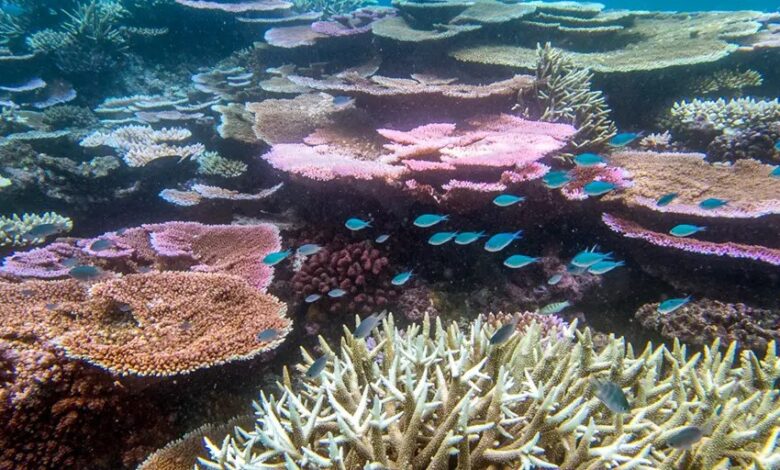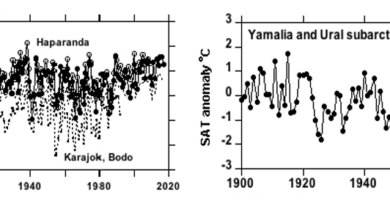Wrong, New York Times, Great Barrier Reef Not in Danger – Watts Up With That?


An article dated August 7 in New York Times (NYT) headlined, Rising temperatures raise fears of ‘doom’ of Great Barrier Reef within a generation claims that recent warming ocean temperatures could spell disaster for the Great Barrier Reef (GBR) within 30 years. While there may be some truth in the temperature data, the claim of the GBR’s demise is false and ignores the temperature history and evolution of the GBR over thousands of years.
The article asserts:
This generation could see the demise of the Great Barrier Reef if humans don’t act more urgently to control climate change, according to scientists in Australia who have just published new research on the temperature of the surrounding ocean.
The Great Barrier Reef is the world’s largest coral reef system and is often referred to as the largest living structure on Earth. Research, published Wednesday in the journal Naturefound that recent extreme temperatures in the Coral Sea were the highest in at least the past 400 years, according to their analysis.
It includes models that show what’s driving those extremes: greenhouse gas emissions from humans burning fossil fuels and destroying natural places that store carbon, like forests.
Claims of the GBR’s collapse due to climate change have has existed for decadesSuch claims often cite sea level rise (SLR), rising temperatures, or both. However, the truth is that corals thrive in warmer waters and are more likely to cope with SLR.
The Australian GBR began to form in the early Holocene period after 9,000 years ago, and the maximum sea level of the Holocene period occurred around 5,000 to 6,000 years ago. The evolution of the GBR during the Holocene period was influenced by a number of factors, including sea level rise, tectonic deformation, and sedimentation rates.
Sea level increased rapidly thereafterflooded the continental shelf by about 6–7 meters every thousand years until about 7,000 years ago. Corals kept up with SLR rates significantly faster than those measured today. NASA satellite instruments, with data going back to 1993, show that global sea levels were rising at a rate only 1.2 inches per decadeor 120 inches (3 meters every thousand years)
Coral evidence shows Ocean temperatures at Heron Reef in the GBR were colder than present between 5,200 and 7,000 years ago. However, other evidence suggests that a warm period known as the Mid-Holocene Thermal Maximum occurred between 6,000 and 6,800 years ago, when the tropical ocean surface was about 1°C warmer than today. Figure 1 below shows how temperatures then compare to today.

As discussed in Climate at a Glance – Coral ReefsCorals have existed continuously in the past. 60 million yearsthrive amid and extend their range of temperatures and carbon dioxide levels significantly higher than Earth experiences today, or any levels that can be reasonably expected in the future. The main causes of coral bleaching events, which vary considerably depending on time and location, include sediment and chemical pollution from nearby coastal lands, chemicals found in sunscreens (oxybenzone), fertilizer and nitrogen loading from agriculture, and cold temperature events. The argument that corals are being devastated by human-made carbon dioxide emissions is easily refuted by the available data.
It is clear that corals in the GBR have survived temperatures and sea levels far greater than those currently occurring. The study cited by the NYT article used computer models to predict the future of the GBR, but completely ignored past temperature and sea level history.
But the final push back against claims of a GBR collapse comes with the latest data. As pointed out here in Climate realism just a month ago, Despite what the media tells you, GBR is at an all-time highas shown in Figure 2 below.

To be clear, in recent decades the extent of the GBR has been lower, much lower than it is now, as ocean temperatures have cooled, and it has expanded significantly following bleaching events.
Concerns about the collapse of the GBR do not reflect the actual data, the history of the GBR, or current experience on the reef. The threats exist only in the models, in the minds of researchers, and in the minds of the so-called journalists who promote this idea. There is no evidence that climate change is worsening the health of the GBR. The resilience of the GBR serves as a reminder that nature is more adaptable and resilient than we often think. The NYT was irresponsible in publishing this article, even though it was full of inaccuracies and misleading statements. But that seems to be the norm for the media today, ignoring history, context, and data to dogmatically promote the climate disaster narrative.
Originally posted at ClimateREALISM
Related



